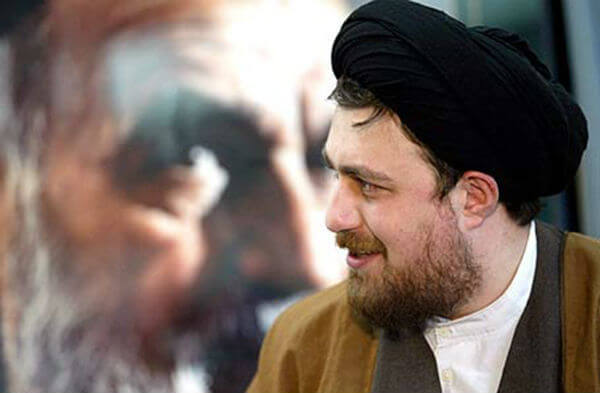
A special correspondent for Foreign Policy reports: Hassan Khomeini, the best-known grandson of Ayatollah Ruhollah Khomeini, registered on Dec. 18 as a candidate in next year’s elections for the Assembly of Experts. The 88-member committee is charged with selecting Iran’s next supreme leader when the incumbent, Ayatollah Ali Khamenei, who is 76 years old and is said to be ailing, dies. The young Khomeini is the first member of his family to seek public office since the death in 1989 of his feted grandfather, who founded the Islamic Republic and served as its first supreme leader. The only question is whether the 43-year-old will be allowed to embark on a path that could eventually lead to the very top of Iran’s complex power structure.
Hassan was born in Qom, the center of religious education in Iran, and home to the country’s clerical political establishment. Hassan’s father, Ahmad, was involved only peripherally in government, having played an influential role in assisting his own father after the long-exiled ayatollah’s triumphant return to Tehran in February 1979. Had he not died of a heart attack in 1995, Ahmad might have preceded his son’s entry to electoral politics.
But now it is Hassan who is moving to center stage.
Having studied and taught in Qom, his main job has been running the mausoleum in Tehran where his father and grandfather are interred, considered a hallowed task by many in Iran. He first started stirring notice in political circles in 2008, when he implicitly criticized Iran’s new political and military elite, which has filled its pockets even while preaching loyalty to the revolution’s founder and the Iranian people.
The IRGC, established by the first supreme leader to protect Iran from foreign and domestic threats, proved its worth during the Iran-Iraq war — but has since earned the enmity of many Iranians by engaging in widespread cronyism and throwing its weight behind the most hard-line figures in the Islamic Republic.
“Those who claim to be loyal to Imam Khomeini should follow his order that the military must stay out of politics,” the younger Khomeini said in an explosive speech when the IRGC was flexing its muscles in 2008 by supporting then-President Mahmoud Ahmadinejad. Khomeini met with reformists before the election the following year and then spoke out in support of the movement’s two defeated candidates, Mir-Hossein Mousavi and Mehdi Karroubi, who claimed the presidential ballot was rigged.
Keeping such company earned Khomeini some credit among moderates. He also shunned Ahmadinejad’s inauguration ceremony, depriving the event of the legitimacy of his family’s endorsement.
Supporters have long wanted Khomeini to enter the public arena. He is markedly younger than the current crop of top Iranian politicians and has already shown something of a youthful, common touch: He’s known to be a fan of Iran’s soccer league and has appeared as a guest on a popular television fanzine. On the show, he said he thought he could have had a career in the game if his grandfather had not ordered him to deepen his religious studies when he was 21 years old.
Khomeini’s 18-year-old son, Ahmad, is another asset. He has 188,000 followers on Instagram, which unlike Facebook or Twitter is not blocked in Iran and offers his father a unique platform to connect with young voters. The Instagram feed provides an insight into the societal change that Khamenei shows no willingness to acknowledge: Photos show Ahmad in Nike sports clothes at a time when Khamenei says American brands should be banned. Yet the teenager is also reverent toward his ancestors, posting pictures of his great-grandfather (who famously branded America “the Great Satan”) and he has taken part in religious ceremonies himself, seamlessly inhabiting both the old and new Iran. [Continue reading…]

